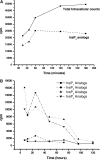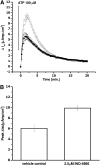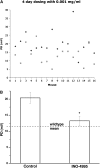INO-4995 therapeutic efficacy is enhanced with repeat dosing in cystic fibrosis knockout mice and human epithelia
- PMID: 19346319
- PMCID: PMC2809217
- DOI: 10.1165/rcmb.2008-0380OC
INO-4995 therapeutic efficacy is enhanced with repeat dosing in cystic fibrosis knockout mice and human epithelia
Abstract
Progressive lung damage in cystic fibrosis (CF) has been linked to inadequate airway mucosal hydration. We previously demonstrated that an inositol tetrakisphosphate analog, 1-O-octyl-2-O-butyryl-myo-inositol 3,4,5,6-tetrakisphosphate octakis(propionoxymethyl)ester (INO-4995), regulates airway secretory and absorptive processes, affecting mucosal hydration by prolonged (24 h) inhibition of Na(+) and fluid absorption in CF human nasal epithelia (CFHNE). The objectives of this study were to further assess clinical potential of INO-4995 in CF through ascertaining in vivo activity in mice with CF, determining the effects of repeated administration on potency and determining cytoplasmic half-life. Uptake and metabolism of [(3)H]INO-4995 was monitored with HPLC to calculate intracellular half-life. INO-4995 was administered in vitro repeatedly over 4 to 8 days to CFHNE. Fluid absorption was assessed by blue dextran exclusion, and basal short-circuit current was measured in Ussing chambers. INO-4995 (1-100 microg/kg) was dosed intranasally either as a single dose or once per day over 4 days to gut-corrected CF mice. [(3)H]INO-4995 was rapidly taken up by epithelial cultures and converted to the active drug, which had a half-life of 40 hours. Repeated daily application of INO-4995 to CFHNE lowered the effective concentration for inhibition of fluid absorption and amiloride-sensitive short-circuit current in cultured CFHNE, and reduced nasal potential difference to nearly control levels in gut-corrected CF mice. Ca(2+)-activated Cl(-) channel activity was also boosted in cultures. Mouse nasal levels fell from abnormal levels to within 2 muA of normal with repeated exposure to 0.8 microg/kg over 4 days. These data support further development of INO-4995 for the treatment of CF.
Figures







Similar articles
-
Control of TMEM16A by INO-4995 and other inositolphosphates.Br J Pharmacol. 2013 Jan;168(1):253-65. doi: 10.1111/j.1476-5381.2012.02193.x. Br J Pharmacol. 2013. PMID: 22946960 Free PMC article.
-
Inositol polyphosphate derivative inhibits Na+ transport and improves fluid dynamics in cystic fibrosis airway epithelia.Am J Physiol Cell Physiol. 2005 Sep;289(3):C512-20. doi: 10.1152/ajpcell.00591.2004. Epub 2005 Apr 27. Am J Physiol Cell Physiol. 2005. PMID: 15857902 Free PMC article.
-
Hyperabsorption of Na+ and raised Ca(2+)-mediated Cl- secretion in nasal epithelia of CF mice.Am J Physiol. 1994 May;266(5 Pt 1):C1478-83. doi: 10.1152/ajpcell.1994.266.5.C1478. Am J Physiol. 1994. PMID: 7515571
-
Extracellular zinc and ATP restore chloride secretion across cystic fibrosis airway epithelia by triggering calcium entry.J Biol Chem. 2004 Mar 12;279(11):10720-9. doi: 10.1074/jbc.M313391200. Epub 2003 Dec 29. J Biol Chem. 2004. PMID: 14701827
-
Pharmacotherapy of the ion transport defect in cystic fibrosis: role of purinergic receptor agonists and other potential therapeutics.Am J Respir Med. 2003;2(4):299-309. doi: 10.1007/BF03256658. Am J Respir Med. 2003. PMID: 14719996 Review.
Cited by
-
Monitoring the cellular metabolism of a membrane-permeant photo-caged phosphatidylinositol 3,4,5-trisphosphate derivative.Chem Phys Lipids. 2021 Nov;241:105124. doi: 10.1016/j.chemphyslip.2021.105124. Epub 2021 Sep 9. Chem Phys Lipids. 2021. PMID: 34509466 Free PMC article.
-
Control of TMEM16A by INO-4995 and other inositolphosphates.Br J Pharmacol. 2013 Jan;168(1):253-65. doi: 10.1111/j.1476-5381.2012.02193.x. Br J Pharmacol. 2013. PMID: 22946960 Free PMC article.
-
Cystic fibrosis transmembrane conductance regulator modulators for personalized drug treatment of cystic fibrosis: progress to date.Drugs. 2010 Feb 12;70(3):241-59. doi: 10.2165/11316160-000000000-00000. Drugs. 2010. PMID: 20166764 Review.
-
Measurement of the airway surface liquid volume with simple light refraction microscopy.Am J Respir Cell Mol Biol. 2011 Sep;45(3):592-9. doi: 10.1165/rcmb.2010-0484OC. Epub 2011 Jan 14. Am J Respir Cell Mol Biol. 2011. PMID: 21239602 Free PMC article.
References
-
- Boucher RC. Regulation of airway surface liquid volume by human airway epithelia. Pflugers Arch 2003;445:495–498. - PubMed
-
- Boucher RC. New concepts of the pathogenesis of cystic fibrosis lung disease. Eur Respir J 2004;23:146–158. - PubMed
-
- Tarran R. Regulation of airway surface liquid volume and mucus transport by active ion transport. Proc Am Thorac Soc 2004;1:42–46. - PubMed
Publication types
MeSH terms
Substances
Grants and funding
LinkOut - more resources
Full Text Sources
Other Literature Sources
Medical
Molecular Biology Databases
Miscellaneous

